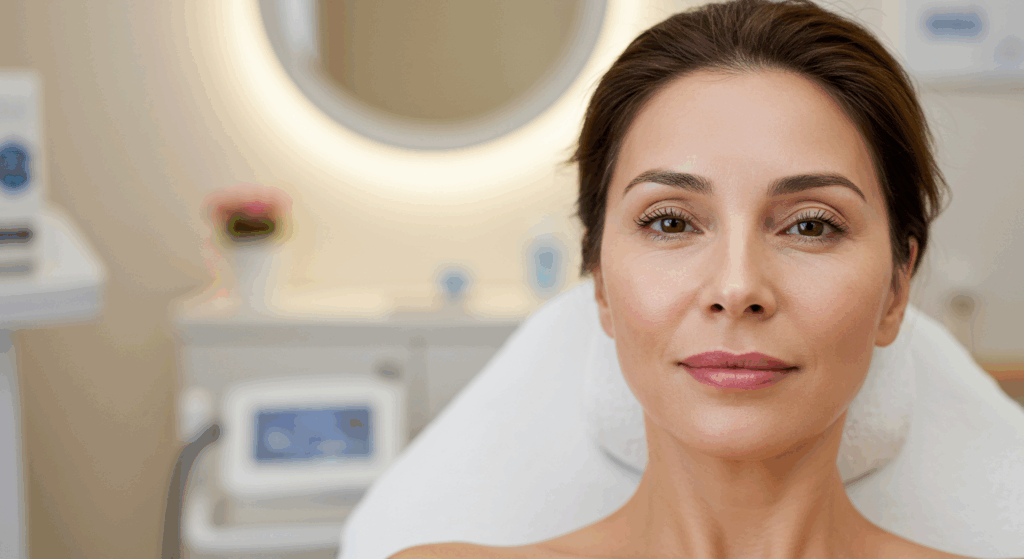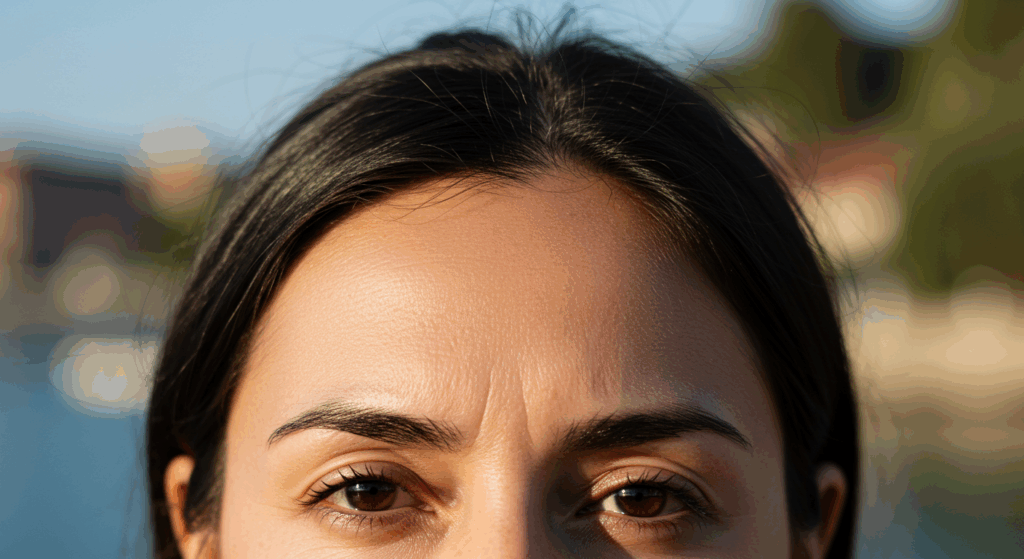Forehead lines, also known as rhytides frontales or worry lines, are horizontal creases that appear on the forehead. These lines are a common sign of facial aging and can significantly impact an individual’s perceived age and emotional expression. For those seeking solutions in a vibrant medical tourism destination like Antalya, understanding the underlying anatomy and the various factors contributing to their formation is the first crucial step towards effective treatment. From a surgeon’s perspective, a comprehensive approach to addressing forehead lines requires a nuanced understanding of the interplay between skin structure, muscle activity, and the aging process.
The formation of forehead lines is primarily attributed to the repetitive contraction of the frontalis muscle. This large, thin muscle originates from the galea aponeurotica (a fibrous sheet covering the top of the skull) and inserts into the skin of the eyebrows and forehead. Its primary action is to elevate the eyebrows and create expressions of surprise, attention, or worry. Over time, these repeated muscle contractions cause the overlying skin to fold and crease. As the skin loses its elasticity and collagen support with age, these temporary dynamic lines gradually become more pronounced and persistent, eventually evolving into static wrinkles that are visible even when the facial muscles are at rest.

Factors Contributing to Forehead Line Development
Several factors contribute to the development and severity of forehead lines:
- Age: As we age, the production of collagen and elastin, the structural proteins responsible for skin firmness and elasticity, naturally declines. This loss of support makes the skin more susceptible to wrinkling from muscle activity.
- Genetics: Predisposition to developing forehead lines can be inherited. Some individuals may naturally have thinner skin or a more active frontalis muscle.
- Sun Exposure (Photoaging): Ultraviolet (UV) radiation from the sun is a major extrinsic factor in skin aging. Chronic sun exposure damages collagen and elastin fibers, leading to premature wrinkling, including forehead lines.
- Facial Expressions: Habitual raising of the eyebrows, even unconsciously, can accelerate the formation of forehead lines. Professions or habits that involve frequent upward gazing can contribute.
- Lifestyle Factors: Smoking, poor diet, dehydration, and lack of sleep can all contribute to premature skin aging and exacerbate the appearance of forehead lines.
- Gravity: Over time, the effects of gravity can cause the skin on the forehead to sag slightly, making existing lines appear deeper.

Non-Surgical Treatment Options for Forehead Lines in Antalya
Antalya offers a wide array of non-surgical treatments designed to address forehead lines, ranging from minimally invasive injectables to energy-based therapies. These options can provide significant improvement, although their results are typically temporary and require maintenance.
Botulinum Toxin (Botox) Injections
Botulinum toxin, as discussed previously, is a neuromodulator that works by temporarily blocking the nerve signals that cause muscle contractions. When injected strategically into the frontalis muscle, Botox can effectively relax the muscle activity that leads to the formation of dynamic forehead lines. This allows the overlying skin to smooth out, reducing the appearance of existing wrinkles and preventing the formation of new ones.
- Mechanism of Action (Simplified): Botox essentially tells the muscles to “relax” by interfering with the chemical signals that make them contract.
- Procedure: Tiny amounts of Botox are injected into specific points across the forehead using a fine needle. The procedure is relatively quick and typically involves minimal discomfort.
- Results: Improvement in forehead lines is usually noticeable within a few days, with the full effect visible within one to two weeks. The results typically last for 3-4 months, after which repeat treatments are necessary to maintain the effect.
- Considerations: Precise injection technique and a thorough understanding of facial anatomy are crucial to achieve natural-looking results without affecting eyebrow movement excessively.
Dermal Fillers
Dermal fillers are injectable substances, often made of hyaluronic acid (HA), that are used to restore lost volume, smooth out wrinkles, and enhance facial contours. While primarily used for static wrinkles and volume loss in other areas of the face, certain types of dermal fillers can be used cautiously to soften deep, static forehead lines by physically filling the creases.
- Mechanism of Action (Simplified): Fillers act like a “plumper” that is injected directly into the wrinkles to fill them out and make them less noticeable.
- Procedure: Small amounts of filler are injected directly into the forehead lines using a fine needle or cannula (a blunt-tipped needle).
- Results: The results are immediate, providing a noticeable smoothing effect. The longevity of fillers varies depending on the type of filler used and individual factors, typically ranging from 6 to 18 months.
- Considerations: The use of dermal fillers in the forehead requires careful consideration due to the complex anatomy and the risk of vascular complications if injected improperly. Experienced injectors with a deep understanding of facial vasculature are essential. The goal is to soften the lines without creating an unnatural or heavy appearance.
Chemical Peels
Chemical peels involve the application of a chemical solution to the skin, which exfoliates the outer layers, revealing smoother, more youthful skin underneath. Different types of peels, ranging from superficial to deep, can be used to address forehead lines.
- Mechanism of Action (Simplified): Chemical peels essentially “shed” the old, damaged outer layers of skin to reveal fresher skin with improved texture and reduced wrinkles.
- Procedure: A chemical solution (e.g., glycolic acid, salicylic acid, TCA) is applied to the forehead and left on for a specific time before being neutralized.
- Results: Superficial peels can provide subtle improvement in fine lines and skin texture with minimal downtime. Medium to deep peels can offer more significant reduction in deeper forehead lines but involve longer recovery periods with redness and peeling.
- Considerations: The depth of the peel needs to be carefully chosen based on the severity of the lines and the patient’s skin type. Deeper peels carry a higher risk of side effects, such as prolonged redness, pigmentation changes, and scarring. Sun protection is crucial after any chemical peel.
Microneedling
Microneedling, also known as collagen induction therapy, involves using a device with fine, short needles to create thousands of tiny micro-injuries in the skin. This controlled injury stimulates the body’s natural healing response, leading to the production of new collagen and elastin, which can improve skin texture and reduce the appearance of fine lines and wrinkles.
- Mechanism of Action (Simplified): Microneedling “tricks” the skin into thinking it’s injured, prompting it to produce more of the building blocks that keep it smooth and firm.
- Procedure: A handheld device with tiny needles is rolled or stamped across the forehead, creating micro-channels in the skin. Topical serums containing growth factors or hyaluronic acid are often applied during or after the procedure to enhance results.
- Results: Improvement is gradual as new collagen is produced over several weeks to months. Multiple treatment sessions are typically recommended for optimal results.
- Considerations: Microneedling is generally well-tolerated, with mild redness and swelling immediately after the procedure. Deeper microneedling can have a longer downtime.
Laser and Energy-Based Treatments
Various laser and energy-based devices can be used to address forehead lines by delivering targeted energy to the skin, stimulating collagen production and skin tightening. Examples include:
- Fractional Laser Resurfacing: This type of laser creates microscopic columns of thermal injury in the skin, leaving the surrounding tissue intact to promote faster healing and collagen remodeling. It can effectively reduce fine lines and improve skin texture.
- Radiofrequency (RF) Therapy: RF devices use electromagnetic waves to heat the deeper layers of the skin, stimulating collagen and elastin production and leading to skin tightening.
- Ultrasound Therapy (Ultherapy): Focused ultrasound energy is delivered to specific depths below the skin surface, stimulating collagen production in the deeper structural layers, resulting in gradual skin tightening and lifting.
- Mechanism of Action (Simplified): These treatments use energy to “reheat” the deeper layers of the skin, encouraging it to produce more of the substances that make it firm and smooth.
- Procedure: The specific device is applied to the forehead, delivering controlled pulses of energy. Discomfort levels vary depending on the device and settings used.
- Results: Improvement is often gradual, with collagen remodeling occurring over several weeks to months. Multiple treatment sessions may be recommended.
- Considerations: The choice of laser or energy-based treatment depends on the severity of the lines, skin type, and desired outcome. These procedures should be performed by experienced professionals to minimize the risk of side effects such as burns or pigmentation changes.

Surgical Treatment Options for Forehead Lines in Antalya
For individuals with deep, static forehead lines or significant forehead laxity, surgical procedures can offer more dramatic and long-lasting results. In Antalya, skilled plastic surgeons offer various surgical options:
Brow Lift (Forehead Lift)
A brow lift, also known as a forehead lift or rhytidectomy of the upper face, is a surgical procedure designed to address sagging eyebrows, forehead wrinkles, and frown lines between the eyebrows. It can significantly improve the appearance of forehead lines by smoothing the skin and repositioning the underlying tissues. Several brow lift techniques exist:
- Coronal Brow Lift (Open Brow Lift): This traditional technique involves a long incision across the top of the head, from ear to ear. The forehead skin is lifted, excess skin and muscle are removed, and the remaining skin is redraped and sutured. While effective for significant lifting, it can result in a longer scar and potential numbness of the scalp.
- Endoscopic Brow Lift: This minimally invasive technique involves several small incisions in the scalp through which an endoscope (a thin tube with a camera) and specialized instruments are inserted. The surgeon can then lift and reposition the forehead tissues and muscles, securing them with sutures or fixation devices. This technique results in smaller scars and a shorter recovery period compared to the coronal lift.
- Temporal Brow Lift (Lateral Brow Lift): This technique focuses on lifting the outer portion of the eyebrows, which often droop first. It involves smaller incisions in the temples and can improve forehead lines in the lateral forehead and reduce crow’s feet.
- Hairline Brow Lift (Pretrichial Brow Lift): This technique involves an incision along the hairline. It is particularly useful for individuals with a high hairline as it can also lower the hairline slightly while lifting the brows and smoothing forehead lines.
- Mechanism of Action (Simplified): A brow lift surgically tightens the skin and underlying tissues of the forehead, effectively smoothing out wrinkles and lifting sagging eyebrows.
- Procedure: The specific technique depends on the patient’s anatomy and desired outcome. All brow lift procedures involve incisions, lifting of the forehead skin, and repositioning or removal of underlying tissues.
- Results: The results of a brow lift are long-lasting, often lasting for many years. However, the aging process will continue, and some recurrence of wrinkles may occur over time.
- Considerations: A brow lift is a more invasive procedure with a longer recovery period compared to non-surgical options. Potential risks include scarring, numbness, hair loss along the incision line, and asymmetry. Choosing a board-certified plastic surgeon with extensive experience in facial rejuvenation is crucial.
Upper Blepharoplasty (Eyelid Lift)
While primarily addressing sagging skin and excess fat in the upper eyelids, an upper blepharoplasty can indirectly improve the appearance of upper forehead lines by reducing the need to compensate for heavy eyelids by constantly raising the eyebrows.
- Mechanism of Action (Simplified): By removing excess skin and fat from the upper eyelids, this procedure can make the eyes look more open and refreshed, potentially reducing the subconscious need to raise the eyebrows.
- Procedure: Incisions are made in the natural creases of the upper eyelids, through which excess skin and fat are removed. The incisions are then closed with fine sutures.
- Results: The results are typically long-lasting, although the skin will continue to age.
- Considerations: This procedure focuses on the eyelids but can have a subtle impact on forehead lines caused by compensatory eyebrow elevation.
Choosing the Right Treatment in Antalya: A Personalized Approach
The best approach for fixing forehead lines in Antalya depends on several factors, including the severity of the lines, the patient’s age, skin type, desired outcome, budget, and tolerance for downtime. A thorough consultation with a qualified dermatologist or plastic surgeon is essential to discuss the available options, understand their benefits and limitations, and develop a personalized treatment plan.
Consultation Process
During the consultation, the practitioner will:
- Evaluate your forehead lines: Assess the depth, extent, and underlying causes of your forehead wrinkles.
- Review your medical history: Inquire about any medical conditions, medications, and previous cosmetic treatments.
- Discuss your aesthetic goals: Understand what you hope to achieve with the treatment.
- Explain the different treatment options: Provide detailed information about the procedures, including their mechanism of action, expected results, potential risks, and recovery process.
- Recommend a personalized treatment plan: Suggest the most appropriate options based on your individual needs and goals.
- Provide realistic expectations: Ensure you understand what can and cannot be achieved with the chosen treatments.
Maintaining Results and Preventing Future Forehead Lines
Regardless of the treatment chosen, maintaining the results and preventing the formation of future forehead lines involves a consistent skincare routine and healthy lifestyle habits:
- Sun Protection: Daily use of a broad-spectrum sunscreen with an SPF of 30 or higher is crucial to protect the skin from further UV damage.
- Moisturization: Keeping the skin well-hydrated helps to maintain its elasticity and reduce the appearance of fine lines.
- Healthy Lifestyle: Avoiding smoking, maintaining a balanced diet, getting adequate sleep, and managing stress can all contribute to healthier, younger-looking skin.
- Consider Maintenance Treatments: For non-surgical options like Botox and fillers, regular maintenance treatments are necessary to sustain the results.
Conclusion: Achieving a Smoother Forehead in Antalya
Antalya offers a comprehensive range of effective treatments for addressing forehead lines, from minimally invasive injectables to advanced surgical procedures. By understanding the underlying causes of these wrinkles and the various treatment options available, individuals can make informed decisions in consultation with qualified medical professionals. Whether opting for the temporary yet significant improvement offered by Botox, the volume restoration of fillers, the skin resurfacing of lasers, or the long-lasting effects of a brow lift, the goal is to achieve a smoother, more youthful forehead that enhances overall facial harmony and boosts self-confidence. A personalized approach, combined with realistic expectations and a commitment to skin health, is key to achieving the best possible outcome in your journey to address forehead lines in Antalya.
Discover the expertise of Dr. Ebru Okyay, your trusted dermatologist in Antalya. Whether you’re looking to address medical skin concerns or enhance your natural beauty with cosmetic treatments, Dr. Okyay is here to help. With personalized care and advanced techniques, achieving your skin goals has never been easier.
